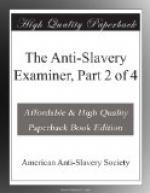3. He thought that the assembly acted very wisely in rejecting the apprenticeship. He considered it absurd. It took the chains partly from off the slave, and fastened them on the master, and enslaved them both. It withdrew from the latter the power of compelling labor, and it supplied to the former no incentive to industry.
He was opposed to the measures which many had adopted for further securing the benefits of emancipation.—He referred particularly to the system of education which now prevailed. He thought that the education of the emancipated negroes should combine industry with study even in childhood, so as not to disqualify the taught for cultivating the ground. It will be readily seen that this prejudice against education, evidently the remains of his attachment to slavery, gives additional weight to his testimony.
The Mansion on the Rock (which from its elevated and almost inaccessible position, and from the rich shrubbery in perpetual foliage surrounding it, very fitly takes the name of Green Castle) is memorable as the scene of the murder of the present proprietor’s grandfather. He refused to give his slaves holiday on a particular occasion. They came several times in a body and asked for the holiday, but he obstinately refused to grant it. They rushed into his bedroom, fell upon him with their hoes, and killed him.
On our return to St. John’s, we received a polite note from a colored lady, inviting us to attend the anniversary of the “Juvenile Association,” at eleven o’clock. We found about forty children assembled, the greater part of them colored girls, but some were white. The ages of these juvenile philanthropists varied from four to fourteen. After singing and prayer, the object of the association was stated, which was to raise money by sewing, soliciting contributions, and otherwise, for charitable purposes.
From the annual report it appeared that this was the twenty-first anniversary of the society. The treasurer reported nearly L60 currency (or about $150) received and disbursed during the year. More than one hundred dollars had been given towards the erection of the new Wesleyan chapel in St. John’s. Several resolutions were presented by little misses, expressive of gratitude to God for continued blessings, which were adopted unanimously—every child holding up its right hand in token of assent.
After the resolutions and other business were despatched, the children listened to several addresses from the gentlemen present. The last speaker was a member of the assembly. He said that his presence there was quite accidental; but that he had been amply repaid for coming by witnessing the goodly work to which this juvenile society was engaged. As there was a male branch association about to be organized, he begged the privilege of enrolling his name as an honorary member, and promised to be a constant contributor to its funds. He concluded by saying, that though he had not before enjoyed the happiness of attending their anniversaries, he should never again fail to be present (with the permission of their worthy patroness) at the future meetings of this most interesting society. We give the substance of this address, as one of the signs of the times. The speaker was a wealthy merchant of St. John’s.




